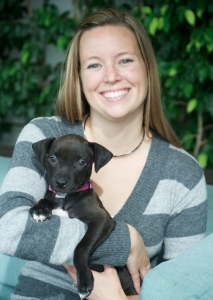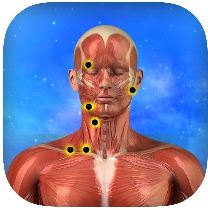
My name is Erin Kowalski and I became a certified canine massage therapist almost 5 years ago. Based out of Chicago, I started my own business, AURA Natural Pet three years ago and provide in-home small mammal (mostly canine) massage therapy and Reiki sessions.
I currently have about 15 appointments a week, which I consider full time, and volunteer the remainder of my time with Bialy’s Wellness Foundation and the local animal rescue community, providing free services. Recently my specialty niche has been working with dogs who have pelvic limb mobility issues, particularly lameness/paralysis, as well as dogs who are nervous, anxious and fearful.
2. Tell us why you chose to go into massage and at what point in your life did you decide to do so? What were you doing at the time? Where did you first hear about the massage career? What factors influenced your decision? What were you looking to get out of this decision?
My background is in design but I have always been involved in the animal rescue community. When I moved to Chicago I took up a part time job working with a dog daycare, started fostering dogs and found myself wanting to spend more and more time working with animals.
I ended up switching gears and quit my design job to manage a pet boutique and grooming salon which allowed me more time to focus on getting involved in the rescue community and fostering puppies. Wanting to do something more hands on I researched potential opportunities and found a certification program in canine massage therapy.
Knowing how much this work could benefit dogs of all breeds, ages, temperaments and backgrounds ultimately influenced my decision to pursue a career in canine massage therapy.
3. What were some of your questions and concerns before further pursuing your massage therapy goals? Talk about concerns with school and the profession itself.
It was necessary for me to go to school and work at the same time in order to afford my career change. So finding a program that worked with my schedule was important. I also did some research as far as making sure that the school’s ideas of canine handling, behavior and approach were aligned with mine.
4. What is your specialty and what are the top three contributing factors to your success today?
As mentioned I have been seeing a lot of clients with pelvic limb mobility issues particularly paralyzed dogs as well as dogs who have anxiety or fear. I attribute my success to my desire to always learn more about ways I can help optimize the quality of life of my canine clients.
My quest for learning has allowed me to bring additional modalities into my work as well as share my experience with pet parents. But one of the biggest factors contributing to my success is the passion I have for special needs animals. I fostered and ultimately adopted a special needs terrier mix who was in a wheelchair. She passed away last year and I started a foundation (Bialy’s Wellness Foundation) in her memory.
Our foundation provides families and rescues with special needs animals the equipment, medical care, rehabilitative therapy, training, resources and support necessary to optimize the quality of life of their wonderful animals and promotes the use of alternative modalities, particularly massage therapy.
A blog featured on the foundation’s website allows me to share my experience and knowledge including Bialy’s response to canine massage therapy. Simply educating others on the benefits of canine massage therapy and letting them know it is an option is an important part of the work I do.
5. What do you like about your specialty? What do you like about what you do in general as a career? Why?
I love being able to share my experience with my own animals, foster puppies and continuing education seminars, lectures, symposiums, etc in hopes that it will make other’s going through similar situations easier. Helping an animal feel better, walk easier, have more mobility, become more accepting of touch and less guarded is so rewarding.
6. What do you not like about what you do? Why?
One of the most difficult things about the work I do is dealing with the passing of a client. Because pets have shorter life spans than humans, it is pretty much guaranteed that we will eventually work with a client that will no longer be here. Last year was an extremely difficult year for me.
In total, 23 pets that I knew, many of which were clients, passed away in 2014. I had no idea what to do: how to console the pet parent, how to handle future correspondence or how to appropriately handle my own grief. As a result I am currently taking a 2-year certification course in pet loss and grief counseling.
7. If there were three things you could change about your work or the industry as a whole what would they be? Why would you change them? What would you change them to?
I would require legislation for all practitioners to be nationally certified for small animal massage therapy. Currently there is no regulation in many states as to who can practice canine massage therapy which leaves it open for those who have not been appropriately trained to damage the credibility of this profession.
I would also make sure that a large portion of the teaching curriculum in certification programs would include canine behavior and communication. Before we can effectively put our hands on an animal, it is necessary for us to build up trust and approach with appropriate communication and understanding with each individual client.
This is important for all dogs, but particularly for our anxious, nervous and fearful dogs as well as dogs that are in pain, recovering from surgery and at critical development stages. From my experience this step is imperative to set up a postitive experience for the dog so that they understand our intention and become a willing participant in the massage session. Ultimately this leads to a solid bond and more effective, therapeutic session.
8. How long do you plan to practice and what do you plan to do after?
Working with rescue animals has always been a passion of mine so if I ever stop providing sessions to paying clients I will always be utilizing this work with rescue animals and my own animals. Since starting Bialy’s Wellness Foundation I found myself working more and more to help families and rescues with special needs animals. As a result I feel that my plan would be to incorporate all of my knowledge working with paralyzed animals to help others.
9. Do you currently have another job or business whether full time or part time? Tell us a bit more about it and how you are able to juggle that with your massage career?
In addition to massage therapy I still do a little bit of design work and am an instructor for the Chicago School of Canine Massage, the school I attended for certification. I believe this to be an important part of my career as I stay abreast of the advances and changes that may take place in our field in addition to sharing my own experience with those whose hearts and hands are open to this work.
10. What are some mistakes you made in your career pursuit that you’d like to warn other students about so they can learn from your experience and avoid it?
One of the most difficult things for me to do was say no to a potential client. Because I provide in-home care, I travel to all my clients. When I first started out I was driving up to 2 hours away (each direction) for clients. So a half day of work was taken up just for travel. I highly recommend setting up an area in which you are willing to work and refer to other therapists that work with potential clients outside of your “zone.”
11. What would you advice someone who is looking at massage therapy schools? What do you recommend they look for and how? How do you recommend they determine whether the school is the right one for them?
As mentioned before, finding a school that works with their schedule as well as utilizes practices that are aligned with your own ideals is important. Do your research, call the school or even tour the facility. Talk with previous graduates and get their testimonials.
12. What do you recommend for someone who wants to go to massage school but cannot afford it?
Start saving and look into financial assistance. Perhaps put together a budget that works for you and allows you to save.
13. What are your three biggest points of advice for an aspiring massage therapist today? What should they do/not do? What should they think about and consider?
I’ve heard a lot people who say they really want to pursue a career in canine massage therapy because they work well with animals and don’t really enjoy working with people.
In this field, it is necessary to not just be able to work well with pets as attached to every pet is a pet parent that you have to work with. Do not fool yourself into thinking you won’t be working with people.
14. Any open thoughts / comments – anything else that you’d like to share about yourself, the massage industry, profession, future, etc? If nothing, make one prediction for the future of massage?
I am really excited to be part of this up and coming field. Canine massage therapy has not yet hit critical mass and so there is a lot of room for growth. I feel like there are so many dogs and small mammals out there that can benefit from this work and there are currently less than 85 nationally certified practitioners in North America.
15. What is your passion outside of massage? What are your hobbies and interests which you pursue when you are not working? Tell us why you enjoy what you enjoy.
I am heavily involved in Bialy’s Wellness Foundation and with the rescue community as a foster parent for pups waiting for their forever homes. When not volunteering, I enjoy cooking new recipes, trying new restaurants and traveling with my husband.
Erin Kowalski is a Nationally Certified Canine Massage Therapist, a Reiki Practitioner and an AURA Natural Pet LLC. you can find her on her websites here and here.








Thank you for the article, I am currently working for a residential home builder and want to get away from this type of work. My experience with my job has rewarded me with one thing, the realization that I want to help animals,canines particularly. I have alot of homeowners who value their pets as children and it pains me to not be capable of helping their aging pets. I have owned several canine babies over the years and really feel this is what I want to do with my life.
great Holly! please let us know how we can help